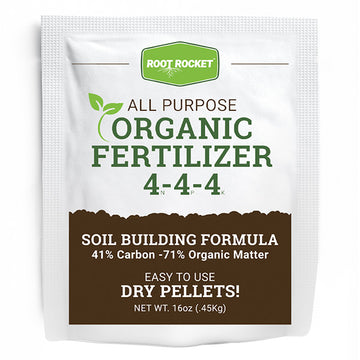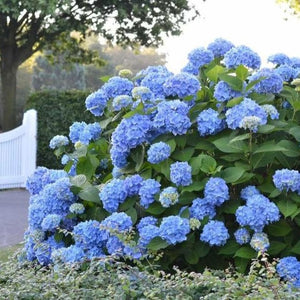Many hydrangea bushes prefer some shade, especially in warmer climates, however, there are cultivars that can not only tolerate sun but also thrive in it. We have versatile hydrangeas that can grow in full shade or full sun. The majority of hydrangeas need some filtered light or a couple of hours of full sun to bloom at their best. In this guide, we’ll cover the best types of hydrangeas for each growing condition and how to best care for them so you get the biggest healthiest blooms.

Hydrangeas for Part Shade: Give Us Some Sunblock Please
Most common hydrangeas prefer a partial sun location - ideally receiving sun in the morning hours and shade in the afternoon. The reblooming Endless Summer® Hydrangea series prefers part shade. These include BloomStruck®, Endless Summer®, Blushing Bride®, and Twist-n-Shout®. Smooth Hydrangeas like the Annabelle Hydrangea prefer at least some shade from the afternoon sun to be really happy. Bigleaf hydrangeas, also known as hydrangea macrophylla, vary especially with some of the newer cultivars being bred to better tolerate heat and sun, but most of these including the mopheads and lacecaps prefer some shade, especially during the afternoon. Make sure your big leaf hydrangeas like Nikko Blue and Glowing Embers get some sun (either a couple of hours of full or several hours of filtered sun) for the best flowering.
The Best Place to Plant Hydrangeas
The best place to plant the majority of Hydrangeas is going to be in a spot that has good drainage, morning sun, and afternoon shade. Hydrangeas can play many roles in your landscape. Most hydrangeas bloom in spring and summer depending on your growing zone. Some can reach heights of 15 feet or higher. Grow them in pots to decorate your patio or apartment balcony. Plant a climbing hydrangea to creep over a trellis or fence. Larger varieties of hydrangeas can be used as a hedge or privacy screen.

Hydrangeas for Full Sun: We Like It Sunny
While most common hydrangea plants need some shade, especially in warmer growing zones, panicle Hydrangeas (Hydrangea paniculata) like Fire Light®, Limelight, Pinky Winky®, Strawberry Sundae®, and Vanilla Strawberry® can thrive in full sun. The new reblooming dwarf series, Let's Dance®, and dwarf big leaf series, Cityline®, actually grow best in full or part sun. And newer smooth hydrangea varieties, Incrediball®, and Invincibelle® Ruby are also recommended for full or part sun.
How to Prevent Leaf Scorch for Full Sun Hydrangeas
Leaf scorch, browning of the leaves, typically occurs during the heat of summer when temperatures are high or it’s warm with low humidity. These conditions cause water to evaporate from the leaves quickly. When there is not enough water for the roots to compensate for the water loss through the leaves, some leaf tissue dies. Your leaves may turn yellow between the veins and brown at the tips – this is a warning before the leaf goes completely brown and dies. To prevent leaf scorch, be sure to provide extra water during stressful times. You may need to irrigate in the morning and evening when temperatures are at their highest. Be sure to water at the base of the plant. Do not allow water to splash over the leaves or blossoms.
Hydrangeas for Sun or Shade: We Go With the Flow
Oakleaf hydrangeas like Alice Oakleaf and Ruby Slippers Oakleaf can tolerate full sun in the northern US but prefer at least some afternoon shade in warm and southern climates. Oakleaf Hydrangeas can tolerate full shade. Oakleaf Hydrangeas are the most adaptable to different sun and shade conditions.

Growing Hydrangeas in the South
Even if the hydrangea care recommendation for your particular plant is full sun you’ll want to offer plenty of water, especially in summer. Deep watering with a hose at the base of your plant is ideal. Do this anytime your soil begins to dry or you notice your plant beginning to wilt. *Wilted leaves on a hydrangea in summer, especially in the southern United States in the late afternoon is not an uncommon sight. Your hydrangea isn’t dying, it’s just thirsty!

Caring for Hydrangeas
When planting hydrangeas be sure you have the right location and conditions for your new plants to thrive. Spring and Fall are ideal times to plant. Avoid planting hydrangeas in summer when temperatures are above 85 degrees.
Soil Conditions
Hydrangeas prefer well-drained soil with an abundance of organic material. If your soil is sandy or heavy in clay, add organic compost at the time of planting. Keep the soil moist, but not saturated, especially in summer and in the first year after planting. Throughout its life Hydrangeas will do best with a deep watering once weekly during hot temperatures. Mulching at about 3 inches deep is highly recommended for hydrangeas. Mulching will cut back on watering needs and protect your plant in extreme temperatures.
Fertilizing
Be sure to check the guidelines for your specific variety. Choose a slow-release fertilizer for flowering plants - a fertilizer that is high in phosphorus. Fertilize once in spring after the last chance of frost and again in early summer for best results. If you have rich soil, you may not need to fertilize your hydrangeas. Too much fertilizer can encourage leafy growth at the expense of blooms.
Pruning Hydrangeas
You don’t need to prune hydrangeas often, but pruning after they are done blooming can help encourage bushier growth and renew an older plant. Before you prune your hydrangeas, it is important to know if your type grows on “old wood” or “new wood”. The most common hydrangea is the Bigleaf variety. These varieties bloom on the previous season’s stems (old wood). Panicle and Smooth hydrangeas bloom on the current season’s stems (new wood). Check your hydrangea type and its guidelines before pruning.
Pruning Old Wood Hydrangeas
Flower buds form in the late summer and flower in the following season, so avoid pruning after August 1st or you’ll risk cutting off next season's flowers.
- Only cut away dead wood in the fall or very early spring.
- To prune, cut one or two of the oldest stems down to the base to encourage branching.
- It’s best not to deadhead the Mopheads. Leave them over winter and cut back in early spring. You can deadhead the Lacecaps.
Pruning New Wood Hydrangeas
- Prune in the late winter when the plant is dormant.
- Only prune dead branches. Do not prune to “shape” the bush.
For a more in-depth article about pruning hydrangeas, see When to Prune Hydrangeas.
You may also like our extensive article about Hydrangea Care where we talk about changing the color of your hydrangeas. Or our article about Hydrangea Types and how they differ.


